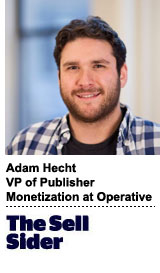 “The Sell Sider” is a column written for the sell side of the digital media community.
“The Sell Sider” is a column written for the sell side of the digital media community.
Today’s column is written by Adam Hecht, vice president of publisher monetization at Operative.
Premium content publishers have a reputation for not being very technical. Any time a new digital channel arises, the more technical it is, the more likely publishers are to outsource or underfund it.
The result is that publishers are beholden to third parties, revenue is depressed and the company loses ground as the world innovates around it. The big threat to publishers’ digital advertising business today is unsold inventory handed to supply-side platforms (SSPs) and other programmatic partners, either directly in a publisher’s header or elsewhere.
The good news is that publishers seem to have learned from past mistakes. A few key factors are driving publishers to take control of the technical aspects of digital advertising and converge programmatic and direct-sold inventory. Advertisers and agencies, for example, want to buy programmatic in the same proposal as direct. In the past, ad networks or Google AdSense served the purpose of filling unsold inventory.
Programmatic also provides many new benefits to both sides, such as pricing controls and inventory flexibility. As a result, publishers can earn more from programmatic, particularly programmatic video, than from direct. Sellers can also discount from the rate card so much that a deal might not be profitable. Programmatic creates competition for the most valuable inventory, raising prices if it’s done correctly.
More broadly, sellers see that they need to actively manage all of their possible revenue channels to be profitable. The digital landscape is changing so quickly – many publishers are now fully focused on mobile and video or native and social – that executives need to maximize yield across every impression or lose their jobs.
Now that publishers are trying to maximize revenue across direct and third-party channels, there is a learning curve. Converging programmatic with direct is both a technical and operational challenge but worth the effort. Publishers typically approach the divergent and converging markets of programmatic and direct with three different philosophies and levels of maturity.
First, fill-focused publishers want to minimize house ads and blanks. While some publishers have fill concerns for branding reasons, this is usually a sign that publishers are looking at their metrics incorrectly. Publishers that care about fill rates may end up working with too many or lower-quality programmatic partners and expose themselves to fraud and low-quality ads that hurt their brand.
On the direct side, caring too much about fill can depress rates, which is very difficult to recover from. These publishers often require a bit of a shake-up, so that executives, sales teams and delivery teams start focusing on revenue and performance metrics over fill.
Next are publishers that want to protect their rate card rates. These publishers often have premium inventory and are concerned that advertisers want to undercut rates by having access to premium content across programmatic channels. This is a fair concern and actually a sign that a publisher is likely ready to converge its direct and programmatic channels for more insight and control. Better to train sales on the benefits of programmatic and embrace a converged strategy soon. Publishers that stay protective of their direct rate card too long may miss out on buyers whose agencies have separate budgets for programmatic deals.
Yield-focused publishers simply want to maximize revenue across every impression. A focus on yield requires total buy-in across sales, delivery and executives. Senior sales people may balk at the idea that their premium buyer could get pushed aside by a programmatic campaign. This approach also can get pushback for the cost of the initial investment. It requires yield optimization technology, a sophisticated analytics team and a totally objective set of sales goals where sellers get compensated on programmatic deals.
While a focus on yield optimization is more of a goal than a reality for many publishers, it’s a good philosophical stance for publishers to take. Ultimately, total focus on yield is a challenge because many platforms are not yet designed to incorporate the two seamlessly. However, this is where the market is going and it is the most profitable option in the long term.
Changing sales goals and training teams to understand the value of programmatic to their clients can reset many legacy parts of the business that were not as profitable as they could be. Hiring operations specialists that are experienced with both direct and programmatic campaigns can create a more flexible delivery team that can also support sellers on hybrid deals such as private marketplace campaigns. Merging reporting and metrics is a bigger challenge.
There are many ways to report on directly sold campaigns, and many ways to report on programmatic performance, but very few can marry both and allow publishers to, at a glance, see performance by ad unit, type or channel. Both require multiple platforms and follow-up Excel work. There are even fewer that allow publishers to, on the fly, change sales proposals to maximize yield without significantly delaying the deal. Currently, no objective solutions exist here. Google’s XSM can do this for DFP and AdX but nothing else right now.
However, the benefits of having a yield-focused philosophy are worth the extra work as systems evolve to catch up. This will be a refreshing change for publishers as they wait for the technology to catch up to them.
Over the long term, quality content and audiences will still get the highest prices. Programmatic won’t change that. Publishers need to prepare their people and operations for a converged programmatic and direct market with an objective focus on maximizing revenue.
Follow Adam Hecht (@OpinionatedAdam), Operative (@Operative) and AdExchanger (@adexchanger) on Twitter.












